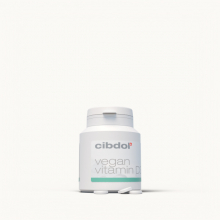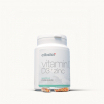The Best Form of Vitamin D for Optimal Absorption
Published:
Vitamin D supplementation is incredibly common, with over 40% of American adults taking a vitamin D supplement. Vitamin D is an essential nutrient that plays many important roles in the body. Getting enough of this vitamin is crucial for bone health and many other aspects of health. But when it comes to vitamin D supplementation, one important question is which form of vitamin D is best for absorption? Read on to learn about the different forms of vitamin D and to find out which is optimal for absorption and boosting vitamin D levels.
Contents:
- Why Vitamin D Matters
- The Different Forms of Vitamin D
- Why Vitamin D3 is Better Absorbed
- How Much Vitamin D3 Should You Take?
- Supplementing Wisely to Avoid Vitamin D Toxicity
- The Takeaway: Vitamin D3 for Optimal Absorption
- Q: What is the best form of vitamin D for optimal absorption?
- Q: What is a vitamin D supplement?
- Q: How much vitamin D is enough?
- Q: What are the signs of vitamin D deficiency?
- Q: Where can I get a good source of vitamin D?
- Q: How is vitamin D absorbed in the body?
- Q: Is there a relationship between vitamin D and overall health?
- Q: Can low vitamin D levels be harmful?
- Q: Can vitamin D be obtained from sunlight?
- Q: Can vitamin D supplements help with vitamin D deficiency?
- Resources used to write this article

Why Vitamin D Matters
Vitamin D is absolutely essential for health. Some of the key reasons this vitamin is so important include:
- Bone health: Vitamin D plays a central role in calcium absorption and bone metabolism. It helps maintain bone mineral density and reduces fracture risk. Getting enough vitamin D is crucial for preventing bone conditions like osteopenia, osteoporosis and rickets.
- Immune regulation: Vitamin D modulates and enhances immune system function. It can reduce risk of illness and infection.
- Chronic disease prevention: Higher vitamin D levels are associated with decreased risks of cardiovascular disease, type 2 diabetes, neurocognitive decline and many other chronic conditions.
- Mood regulation: Vitamin D also influences serotonin synthesis and receptors. Its deficiency has been linked to depression and other mental health conditions.
Given all of these benefits, it's clear that getting sufficient levels of vitamin D should be a priority. But to reap the benefits, it's important that the form of vitamin D you take is well absorbed.
The Different Forms of Vitamin D
There are two main forms of vitamin D that are relevant when it comes to supplementation:
Vitamin D2 (Ergocalciferol)
Vitamin D2 is derived from plant sources. Some mushrooms provide vitamin D2 when exposed to UV light. Vitamin D2 is also manufactured and used to fortify foods like cereal grains and dairy products.
Vitamin D3 (Cholecalciferol)
Vitamin D3 is the form produced naturally in the body when skin is exposed to sunlight. It's also the form found naturally in animal sources like fatty fish, egg yolks, and beef liver. Vitamin D3 used in supplements is usually sourced from lanolin.
Both vitamin D2 and D3 increase blood levels of the active form of vitamin D known as calcitriol. But research has shown that D3 may be superior when it comes to absorption and maintaining vitamin D status in the body.
Why Vitamin D3 is Better Absorbed
Multiple studies have compared the bioavailability and absorption of vitamin D2 versus vitamin D3. The research overwhelmingly shows that vitamin D3 is the preferable form, for several reasons:
- Higher increase in serum vitamin D levels: In a study of healthy adults, vitamin D3 supplementation at 1000 IU daily for 11 weeks increased serum vitamin D levels by approximately 30 nmol/L. Vitamin D2 supplementation led to an increase of only 3 nmol/L. Several other studies found similar results, with vitamin D3 raising vitamin D levels significantly more than an equal dose of D2.
- Longer lasting increase: Vitamin D3 has also been shown to produce a more sustained increase in vitamin D levels compared to D2. In one study, the increase in serum vitamin D remained higher in the D3 group than the D2 group after the supplementation period ended.
- Less dependence on DBP: Vitamin D3 may have higher bioavailability because it has lower affinity for the vitamin D binding protein DBP. Therefore, more free or unbound vitamin D3 becomes available for bodily tissues to use.
- Less enzymatic degradation: There is some evidence that vitamin D3 is less degraded by the enzymatic processes in the liver and kidneys. Vitamin D2 may be more readily broken down and eliminated from the body.
- Known evolutionary preference: Human physiology has evolved to best utilize vitamin D3, as it is the natural form synthesized from sunlight. Given the choice, the body preferentially converts and utilizes vitamin D3.
In summary, vitamin D3 appears superior when it comes to absorption, increasing vitamin D levels, and maintaining improved vitamin D status in the long-term.
How Much Vitamin D3 Should You Take?
The optimal supplemental dose of vitamin D3 will depend on your individual needs and starting vitamin D levels. Here are some general recommendations:
- Deficiency - 50-100 mcg (2000-4000 IU) per day
- Insufficiency - 25-50 mcg (1000-2000 IU) per day
- Maintenance - 10-25 mcg (400-1000 IU) per day
Those who are obese, have malabsorption conditions, or get very little sun exposure may need to take higher doses of vitamin D3 to maintain optimal levels. It's a good idea to get your 25(OH)D levels tested periodically to ensure you are taking the right supplemental dose.
Look for vitamin D3 (cholecalciferol) on the supplement label. Vitamin D3 is preferable to vitamin D2 (ergocalciferol). Vitamin D3 has been shown to produce greater increases in vitamin D levels at equal doses compared to D2.
Timed-release capsules or liquids may aid absorption. Fatty foods can also help improve vitamin D3 absorption.
Supplementing Wisely to Avoid Vitamin D Toxicity
While vitamin D3 has excellent bioavailability, it's important not to overdo it on supplementation. Taking too much vitamin D over time can lead to toxicity with symptoms like nausea, vomiting, weakness, and frequent urination.
Vitamin D toxicity is unlikely below 125 mcg (5000 IU) per day. But it's recommended to stay under 100 mcg (4000 IU) unless directed by a doctor. Get your vitamin D levels tested if you are taking high dose supplements long-term. Target blood levels of vitamin D between 50-80 ng/ml.
The Takeaway: Vitamin D3 for Optimal Absorption
- Vitamin D is an essential vitamin with wide-ranging health benefits. Getting enough vitamin D is important for bone health, immune function, mood regulation and disease prevention.
- Vitamin D3 (cholecalciferol) is the preferred supplemental form of vitamin D compared to vitamin D2. Multiple studies show D3 raises vitamin D levels higher and keeps them elevated longer.
- Vitamin D3 may have superior bioavailability because it has lower affinity for DBP, allowing more to become available for bodily tissues. D3 may also be less degraded by liver enzymes during metabolism.
- To correct deficiency take 2000-4000 IU (50-100 mcg) vitamin D3 per day. For maintenance take 400-1000 IU (10-25 mcg) vitamin D3 daily. Have vitamin D levels tested to ensure optimal dosage.
- Vitamin D3 is generally well absorbed on its own, but absorption can be enhanced by taking it with fatty foods or in timed-release preparations.
- Don't exceed 4000 IU (100 mcg) vitamin D3 per day unless prescribed, as excessive intake can lead to toxicity. Check blood levels periodically if taking high dose supplements.
The research clearly shows that if you want to raise your vitamin D levels efficiently, vitamin D3 is the best form to take. Choosing vitamin D3 over D2 provides optimal absorption and higher blood levels of this essential vitamin. Just be sure to supplement responsibly within the recommended dosing range.
Q: What is the best form of vitamin D for optimal absorption?
A: The best form of vitamin D for optimal absorption is vitamin D3 (cholecalciferol).
Q: What is a vitamin D supplement?
A: A vitamin D supplement is a dietary supplement that provides a concentrated form of vitamin D.
Q: How much vitamin D is enough?
A: The amount of vitamin D needed can vary depending on factors such as age, sex, and overall health. The recommended daily intake of vitamin D for most adults is 600-800 International Units (IU).
Q: What are the signs of vitamin D deficiency?
A: Signs of vitamin D deficiency can include fatigue, muscle weakness, bone pain, and frequent infections.
Q: Where can I get a good source of vitamin D?
A: Vitamin D can be obtained from natural sources such as fatty fish (salmon, mackerel, sardines) and fortified foods like milk, orange juice, and cereals.
Q: How is vitamin D absorbed in the body?
A: Vitamin D is a fat-soluble vitamin, which means it needs to be consumed with dietary fat for optimal absorption. Once absorbed, it is then processed by the liver and the kidneys.
Q: Is there a relationship between vitamin D and overall health?
A: Yes, vitamin D plays a crucial role in overall health. It is essential for the absorption of calcium and phosphorus, which are important for maintaining strong bones and teeth. Vitamin D also supports immune function and helps regulate cell growth and division.
Q: Can low vitamin D levels be harmful?
A: Yes, low levels of vitamin D can have negative health effects. In addition to weakened bones and increased risk of fractures, low vitamin D levels have also been associated with an increased risk of certain chronic diseases.
Q: Can vitamin D be obtained from sunlight?
A: Yes, vitamin D can be synthesized in the skin when it is exposed to sunlight. However, the amount of vitamin D produced through sunlight exposure depends on various factors, such as the time of day, season, geographic location, and individual melanin levels.
Q: Can vitamin D supplements help with vitamin D deficiency?
A: Yes, vitamin D supplements can be an effective way to treat vitamin D deficiency. Your healthcare provider can determine the appropriate dosage based on your individual needs and test results.
Resources used to write this article
Lehmann, U., Hirche, F., Stangl, G. I., Hinz, K., Westphal, S., & Dierkes, J. (2013). Bioavailability of vitamin D(2) and D(3) in healthy volunteers, a randomized placebo-controlled trial. Journal of Clinical Endocrinology and Metabolism, 98(11), 4339–4345. https://doi.org/10.1210/jc.2012-4287
Tripkovic, L., Lambert, H., Hart, K., Smith, C. P., Bucca, G., Penson, S., Chope, G., Hyppönen, E., Berry, J., Vieth, R., & Lanham-New, S. (2012). Comparison of vitamin D2 and vitamin D3 supplementation in raising serum 25-hydroxyvitamin D status: A systematic review and meta-analysis. The American Journal of Clinical Nutrition, 95(6), 1357–1364. https://doi.org/10.3945/ajcn.111.031070
Glendenning, P., Chew, G. T., Seymour, H. M., Gillett, M. J., Goldswain, P. R., Inderjeeth, C. A., Vasikaran, S. D., Taranto, M., & Musk, A. A. (2009). Serum 25-hydroxyvitamin D levels in vitamin D-insufficient hip fracture patients after supplementation with ergocalciferol and cholecalciferol. Bone, 45(5), 870–875. https://doi.org/10.1016/j.bone.2009.07.079
Biancuzzo, R. M., Clarke, N., Reitz, R. E., Travison, T. G., & Holick, M. F. (2013). Serum concentrations of 1,25-dihydroxyvitamin D2 and 1,25-dihydroxyvitamin D3 in response to vitamin D2 and vitamin D3 supplementation. The Journal of Clinical Endocrinology and Metabolism, 98(3), 973–979. https://doi.org/10.1210/jc.2012-2114
Jones, K. S., Assar, S., Harnpanich, D., Bouillon, R., Lambrechts, D., Prentice, A., & Schoenmakers, I. (2014). 25(OH)D2 half-life is shorter than 25(OH)D3 half-life and is influenced by DBP concentration and genotype. The Journal of Clinical Endocrinology and Metabolism, 99(9), 3373–3381. https://doi.org/10.1210/jc.2014-1714











